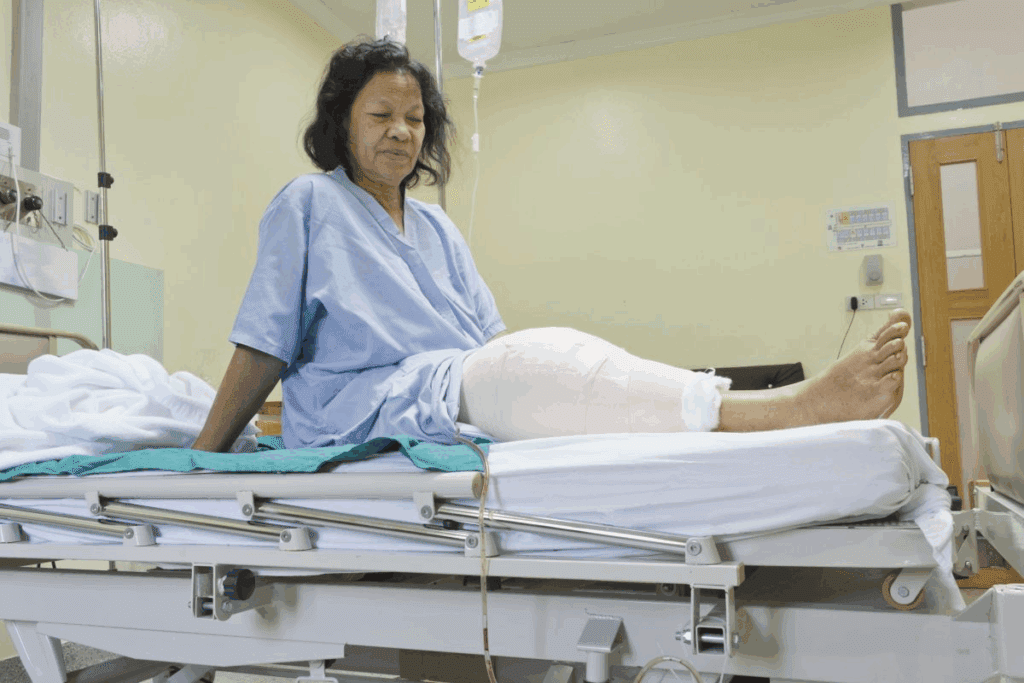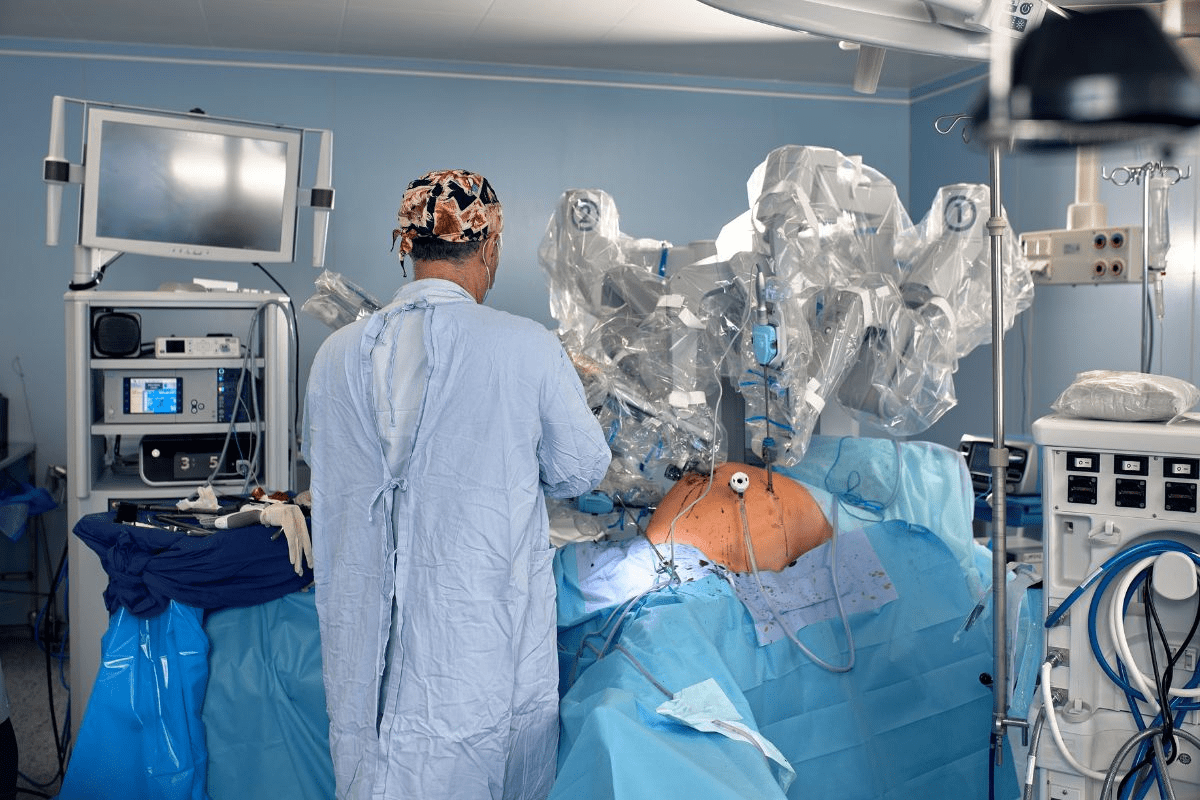Last Updated on November 26, 2025 by Bilal Hasdemir

When the vital pipeline from your heart—the ascending aorta—weakens or tears, every moment counts. Surgical repair of the aorta is a proven treatment for life-threatening conditions such as aortic aneurysms, dissections, and ruptures. Learn how surgical repair of aorta is performed and what techniques doctors use for successful outcomes.
Repairing an ascending aortic aneurysm involves replacing the diseased segment with a synthetic graft, usually made of Dacron. This complex procedure needs careful planning, precise technique, and postoperative care. At places like Liv Hospital, teams use the latest techniques and care with compassion to get the best results.
This guide will take you through the step-by-step process of aorta repair surgery. You’ll learn about preoperative assessment, surgical techniques, and postoperative management. Knowing these steps is key for medical professionals and patients.
Key Takeaways
- Ascending aortic aneurysm repair is a complex procedure that requires careful planning and precise technique.
- The surgical repair involves replacing the diseased segment of the aorta with a synthetic graft.
- Patient-centered care and cutting-edge techniques are key for the best outcomes.
- Preoperative assessment, surgical techniques, and postoperative management are critical for the repair process.
- Understanding the step-by-step guide is essential for medical professionals and patients.
Understanding Ascending Aortic Pathology

The ascending aorta’s condition is complex and needs a deep understanding for surgery. This part of the aorta is key and can face many problems. These issues can be serious if not handled right.
Common Indications for Surgical Repair
Surgery is needed for aortic aneurysms, dissections, and ruptures. These problems can be deadly if not treated quickly. Aortic aneurysms are a big reason for surgery, as they can burst or tear.
Doctors decide on surgery based on the aneurysm size, symptoms, and the patient’s health. Aneurysms over 5.5 cm are usually fixed with surgery because of the high risk of bursting.
Anatomical Considerations of the Ascending Aorta
The anatomy of the ascending aorta is key for surgery. It’s near the heart and has important structures around it. Knowing how the aorta relates to these structures is vital for a good surgery.
| Anatomical Feature | Surgical Consideration |
| Proximity to the heart | Requires careful planning to avoid cardiac complications |
| Surrounding vital structures | Necessitates precise dissection techniques |
| Aortic root involvement | May require root replacement or repair |
Pathophysiology of Aortic Diseases
Aortic diseases like aneurysms and dissections have complex causes. Genetics, high blood pressure, and atherosclerosis play a role. Knowing this helps doctors plan better surgeries.
Understanding these diseases is key for better treatments. This knowledge lets surgeons customize care for each patient. It improves results in aorta repair and replacement of ascending aorta surgeries.
Preoperative Assessment and Planning

Fixing the ascending aorta needs careful planning before surgery. This step is key to picking the right surgery and getting the patient ready.
Diagnostic Imaging Techniques
Imaging tests are very important before surgery for the ascending aorta. Echocardiography, CT scans, and MRI help see the aneurysm’s size and shape. They also check the aortic valve and nearby areas.
“Preoperative imaging is essential for understanding the extent of the aortic pathology and for planning the surgical repair.”
| Imaging Modality | Information Provided | Clinical Utility |
| Echocardiography | Aortic valve function, aortic root dimensions | Assesses valve function and root pathology |
| CT Scans | Aorta dimensions, presence of complications | Provides detailed images for surgical planning |
| MRI | Aortic anatomy, blood flow assessment | Evaluates aortic anatomy and blood flow |
Patient Selection Criteria
Choosing who needs surgery for the ascending aorta is based on several factors. The aneurysm’s size, symptoms, and overall health are important. Those with big aneurysms or symptoms like chest pain are usually operated on.
Timing of Intervention: Emergency vs. Elective
When to have surgery depends on how urgent it is. Emergency surgery is for sudden problems like dissection or rupture. Elective surgery is for stable aneurysms. Choosing between these is a big decision based on careful planning.
In summary, planning and assessment before surgery are essential for fixing the ascending aorta. Using the right imaging tests and choosing the right patients leads to better outcomes.
Surgical Repair of Aorta: Technique Selection
Choosing the right surgical technique for the ascending aorta is key. It depends on the patient’s condition and the disease’s extent. The right choice is vital for a good outcome and lasting repair.
Standard Dacron Graft Replacement
Standard Dacron graft replacement is common for aortic aneurysms and dissections. It involves swapping the diseased part with a Dacron graft. This graft is made of polyester and is sized to fit the patient’s aorta perfectly.
Valve-Sparing Procedures (David Technique)
For patients with a healthy aortic valve, valve-sparing procedures like the David technique are preferred. This method keeps the native valve and avoids the need for blood thinners. It’s great for younger patients who want to keep their valve.
Cabrol Procedure for Complex Cases
The Cabrol procedure is for complex cases with a lot of aortic root involvement. It replaces the aortic root and attaches the coronary arteries to the graft. It’s used when simpler methods won’t work.
Bentall Procedure for Aortic Root Replacement
The Bentall procedure replaces the aortic root and valve with a composite graft. It’s for cases where both the root and valve are diseased. The procedure connects the coronary arteries to the graft for proper heart blood flow.
In summary, picking the right surgical technique for the ascending aorta is based on a detailed patient evaluation. Surgeons must choose wisely to ensure the best results for the patient.
Preparation for Surgery
Getting ready for ascending aorta surgery is key. It makes sure the team is ready for the complex aorta repair. This preparation is vital for a good outcome.
Operating Room Setup
The operating room is ready for cardiopulmonary bypass and more. It has perfusion equipment, monitoring tools, and all the surgical tools needed. Everything is set up to be clean and ready to use.
- Cardiopulmonary bypass machine
- Monitoring devices for vital signs
- Surgical instruments specific to aortic repair
Required Instrumentation and Materials
The team makes sure they have everything needed. This includes surgical tools, sutures, and grafts. For the aorta, a Dacron graft is often used.
Anesthesia Considerations
Anesthesia is very important for safety during surgery. General anesthesia is used. The anesthesia team watches the patient’s vital signs closely.
“The anesthesiologist plays a critical role in managing the patient’s hemodynamics and ensuring optimal conditions for the surgical team.”
— Expert in Cardiac Surgery
Patient Positioning and Draping
Positioning and draping the patient is done carefully. The patient lies on their back. The area to be operated on is cleaned and covered with a sterile sheet.
- Position the patient supine on the operating table.
- Prep the surgical site with antiseptic solution.
- Drape the patient to maintain sterility.
Establishing Cardiopulmonary Bypass
Cardiopulmonary bypass is key in ascending aortic surgery. It makes the surgical area calm and bloodless. This is vital for surgeons to do complex repairs safely.
Cannulation Strategies
Cannulation is a critical step in starting cardiopulmonary bypass. The site for cannulation depends on the patient’s body, the aortic issue, and the surgeon’s choice.
- Arterial Cannulation: Common sites include the femoral artery, axillary artery, or directly into the ascending aorta. The choice is influenced by the need for antegrade or retrograde perfusion.
- Venous Cannulation: Typically involves cannulating the right atrium or vena cavae. The approach may vary based on the need for bicaval cannulation for complex procedures.
Temperature Management
Temperature control is key during cardiopulmonary bypass. Hypothermia is often used to lower metabolic demand and protect vital organs.
- Mild hypothermia (32°C to 35°C) is used for some procedures.
- Moderate hypothermia (26°C to 31°C) is commonly employed for more complex repairs.
- Deep hypothermic circulatory arrest (below 20°C) is reserved for complex aortic arch repairs or when a bloodless field is necessary.
Myocardial Protection Techniques
Myocardial protection is essential to prevent cardiac injury during cardiopulmonary bypass. Techniques include:
- Cardioplegia: A solution that arrests the heart, reducing metabolic demand. It can be administered antegrade or retrograde.
- Cardiac Ischemia Time: Minimizing the duration of cardiac ischemia is critical to prevent myocardial damage.
By carefully managing cardiopulmonary bypass, including cannulation strategies, temperature control, and myocardial protection, surgeons can optimize outcomes in ascending aortic repair.
Step-by-Step Surgical Procedure
A successful repair of the ascending aorta needs a clear understanding of the surgical steps. Each step is vital for a good outcome.
Surgical Approach and Exposure
The first step is to get good exposure. This is done through a median sternotomy. It gives great access to the aorta. Careful dissection is done to see the aorta without harming nearby tissues.
Aortic Resection Technique
After getting good exposure, the diseased part of the aorta is removed. This requires careful planning to know how much to remove. The aorta is clamped on both sides of the diseased area, and then cut.
- Identify the extent of the diseased segment
- Clamp the aorta proximally and distally
- Transect the aorta
Graft Implantation
After removing the diseased part, a graft is put in to replace it. The graft is carefully sized to fit the patient’s aorta. It is sewn in place with a continuous suture.
- Select an appropriately sized graft
- Perform proximal anastomosis
- Perform distal anastomosis
Management of the Aortic Valve and Root
In some cases, the surgery also deals with the aortic valve and root. This might include valve repair or replacement. The choice depends on what the patient needs before and during surgery.
The steps for repairing the ascending aorta are complex. They need a lot of skill and precision. By following these steps carefully, surgeons can help patients get better.
Cerebral Protection Strategies
Surgical repair of the ascending aorta needs careful brain protection to lower neurological risks. Protecting the brain is key in aortic aneurysm surgery. It greatly affects how well a patient does.
“The prevention of neurological injury is key during aortic repair surgery,” studies say. Good brain protection involves many techniques. These ensure the brain stays safe during surgery.
Deep Hypothermic Circulatory Arrest
Deep hypothermic circulatory arrest (DHCA) is a common method for brain protection in complex aortic surgeries. It cools the body to lower metabolic needs. This protects the brain and other organs from damage.
Using DHCA needs careful temperature control and monitoring. It’s important to weigh its benefits against risks like bleeding problems and brain issues.
Selective Cerebral Perfusion Techniques
Selective cerebral perfusion (SCP) is another way to protect the brain during aortic surgery. SCP keeps blood flowing to the brain, even when the aorta is stopped.
SCP is helpful in complex cases where long aortic arrest is needed. It requires precise blood flow to the brain.
Monitoring Neurological Function
It’s vital to watch the brain’s function during and after aortic surgery. Tools like EEG and NIRS give real-time brain activity and oxygen levels.
Spotting brain problems early can lead to better outcomes. Using advanced brain monitoring in surgery improves brain protection.
In summary, protecting the brain is essential in aortic surgery. Using DHCA and SCP, and watching the brain closely, helps avoid brain damage. This leads to better results for patients.
Postoperative Management and Complications
After ascending aorta repair, careful management is key for the best results. This phase is critical for avoiding complications and helping the patient recover well.
Immediate Postoperative Care
Right after surgery, patients are watched closely in the ICU. They are checked for bleeding, heart function, and brain health. Looking out for complications early on is very important for better outcomes.
Common Complications
Even with modern surgery, problems can happen after ascending aorta repair. Issues like bleeding, infection, stroke, and kidney failure can occur. Quick action to address these problems is vital to avoid lasting harm.
- Bleeding: Needs fast attention and might require surgery again.
- Infection: Treated with antibiotics and sometimes surgery.
- Stroke: Checking the brain is key, and treatment may include rehab.
Long-term Follow-up Protocol
Having a plan for long-term follow-up is important after ascending aorta repair. Regular CT scans check the repair’s success and watch for late problems. Long-term care also helps manage risks for more aortic issues, like high blood pressure and high cholesterol.
Patients are told how to live healthier, like eating right, exercising, and quitting smoking. Regular visits with a heart specialist are also important to adjust care as needed.
Conclusion
Surgical repair of the ascending aorta is a complex task. It needs careful planning, precise techniques, and detailed postoperative care. A thorough approach is key to improving patient outcomes.
A team of experts, including cardiothoracic surgeons and intensive care specialists, is vital. They work together to understand the condition, choose the right surgery, and manage care after surgery. This teamwork helps improve results for patients with serious aortic problems.
Mass General Brigham Heart and Vascular emphasizes the importance of a detailed preoperative check-up. The right surgical method and close postoperative care are also critical. By following this approach, healthcare teams can provide better care for patients needing aortic repair.
FAQ
What is the purpose of surgical repair of the ascending aorta?
The main goal is to fix life-threatening problems like aneurysms, dissections, and ruptures. This is done by replacing the bad part with a synthetic graft.
What are the common indications for surgical repair of the ascending aorta?
Surgery is needed for aortic aneurysms, dissections, and ruptures. These are serious and can be deadly if not treated.
What is the role of cardiopulmonary bypass in surgical repair of the ascending aorta?
Cardiopulmonary bypass is key. It lets the team work on a stopped heart. They use it to manage temperature and protect the heart.
What are the different surgical techniques used for repairing the ascending aorta?
There are several methods. These include using a Dacron graft, valve-sparing techniques, and complex procedures like the Cabrol and Bentall.
How is cerebral protection achieved during surgical repair of the ascending aorta?
To protect the brain, deep hypothermic circulatory arrest and selective cerebral perfusion are used. They keep blood flowing to the brain.
What are the possible complications of surgical repair of the ascending aorta?
Risks include bleeding, infection, and brain or heart problems. These are watched closely after surgery.
What is the significance of long-term follow-up after surgical repair of the ascending aorta?
Long-term follow-up is vital. It helps track recovery, catch late problems, and ensure the best outcome.
How is the size of an ascending aortic aneurysm determined, and what size is considered for surgery?
Imaging techniques measure the aneurysm size. Surgery is usually needed for sizes 5.1 cm or larger, or if symptoms appear.
What is the Bentall procedure, and when is it used?
The Bentall procedure replaces the aortic root. It’s used for complex cases involving the aortic root.
What is the role of Dacron grafts in surgical repair of the ascending aorta?
Dacron grafts are synthetic replacements for the diseased aorta. They offer a durable fix for aortic repair.
References
- Manoly, I., Uzzaman, M., Karangelis, D., Kuduvalli, M., Georgakarakos, E., Quarto, C., … Ravishankar, R. (2022). Neuroprotective strategies with circulatory arrest in open aortic surgery – A meta‑analysis. Asian Cardiovascular & Thoracic Annals, 30(6), 635‑644. Retrieved from https://pmc.ncbi.nlm.nih.gov/articles/PMC9260478/






